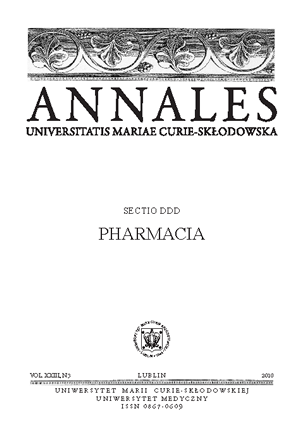Phosphoglucose isomerase from Escherichia coli ATCC 25922 – pilot studies
Keywords:
phosphoglucose isomerase, isoenzymes, PGI inhibitors, Escherichia coli ATCC 25922, biofilmAbstract
Phosphoglucose isomerase (EC 5.3.1.9; PGI) is an enzyme participating in the metabolism of the sugar and carrying the reversible isomerization of glucose-6-phosphate and D-fructose-6-phosphate. It plays key role in the process of the extracellular polysaccharides (EPS) synthesis in vivo – creating the bacterial biofilm. The complete understanding of PGI catalysis and inhibition mechanisms may results in discovery of new PGI inhibitors – antibacterial drugs.
In this pilot study we described the procedure of partial purification of E. coli ATCC 25922 PGI from cytosolic fraction. The activity of enzymes was measured by the conversion of D-fructose-6P into D-glucose-6P. Two forms (isoenzymes I and II) of this enzyme were separated. Some properties of dominant form (isoenzyme I) of PGI were studied. The Km constant for D-fructose-6P was 1 mM. The enzyme had optimum activity in TRIS/HCl buffer, pH 7.65. Phosphoglucose isomerase had molecular weight 120 kDa. Our results indicated that amino acids - cysteine, tryptophan, tyrosine and lysine residues were to be presented in the active site of PGI from E. coli ATCC 25922. The lack of the activity inhibition of characterized enzyme by chelators as EDTA, 1,10-phenantroline and TRIS indicated that the PGI is not a metallprotein. A large similarity between properties of phosphoglucose isomerases isolated from E. coli ATCC 25922 and other E. coli strains such as K10 and ATCC 35218 was discovered.
References
1. Bachman B.J.: Linkage map of Escherichia coli K-12, edition 7. Microbiol. Rev., 47, 180-230.
2. Bradford M.M.: A rapid and sensitive method for the quantitation of microgram quantities of protein utilizing the principle of protein dye binding. Anal. Biochem., 72, 248-254, 1976.
3. Davies C. et al.: The structure of human phosphoglucose isomerase complexed with
a transition-state analoque. Acta Crystallogr. Sect. D Biol. Crystallogr., 59, 1111-1113, 2003.
4. Davis B.: Disc electrophoresis. II Method and application to human serum proteins. Ann N.Y. Acad. Sci., 121, 404-407, 1964.
5. Froman B.E. et al.: Isolation and characterization of the phosphoglucose isomerase gene from Escherichia coli. Mol. Gen. Genet., 217, 126-131, 1989.
6. Fraenkel D.G., Levisohn S.R.: Glucose and gluconate metabolism in an Escherichia coli mutant lacking phosphoglucose isomerase. J. Bacteriol., 93, 1571-1578, 1967.
7. Friedberg I.: Localization of phosphoglucose isomerase in Escherichia coli and its relation to the induction of the hexose phosphate transport system. J. Bacteriol., 112, 1201-1205, 1972.
8. Hansen T. et al.: Cupin-type phosphoglucose isomeraes (Cupin-PGIs) constitute a novel metal-dependent PGI family representing a convergent line of PGI evolution.
J. Bacteriol., 187, 1621-1631, 2005.
9. Hansen T. et al.: Bifunctional phosphoglucose/phosphomannose isomerase from the Archaea Aeropyrum pernix and Thermoplasma acidophilum constitute a novel enzyme family within the phosphoglucose isomerase superfamily. J. Biol. Chem., 279, 2262-2272, 2004.
10. Hua Q. et al.: Response of the central metabolism in Escherichia coli phosphoglucose isomerase and glucose-6-phosphate dehydrogenase knockouts. J. Bacteriol., 185, 7053-7067, 2003.
11. Ishaque A. et al.: On the absence of cysteine in glucose 6-phosphate dehydrogenase from Leuconostoc mesenteroides. Biochem. Biophys. Res. Commun., 59, 894-901, 1974.
12. Jeffery C.J.: Moonlighting proteins. Trends Biochem. Sci., 24, 8-11, 1999.
13. Lever M.: A new reaction for colorimetric determination of carbohydrates. Anal. Biochem., 47, 273-279, 1972.
14. Mathur D., Garg L.C.: Functional phosphoglucose isomerase from Mycobacterium tuberculosis H37Rv: rapid purification with high yield and purity. Protein Expr. Purif., 52, 373-378, 2007.
15. Noltmann E.: Aldose-ketose isomerases. [In] Boyer P., editor. The Enzymes, 6, 3rd edn. New York: Academic Press, 271-298, 1972.
16. Schreyer R., Böck A.: Phosphoglucose isomerase from Escherichia coli K10: purification, properties and formation under aerobic and anaerobic condition. Arch. Microbiol. 127, 289-298, 1980.
17. Swatko M., Szumiło T.: Isolation and partial characterization of a novel ribitol dehydrogenase from mycobacteria. Ann. UMCS, Sect. DDD, XII/XIII, 169-178, 1999/2000.
18. Szynal K.: Purification and evaluation of biological role of phosphoglucomutase (PGM) and phosphoglucoisomerase (PGI) from bacteria cells of Escherichia coli. Master’s thesis. Medical University of Lublin, 2008.
19. Thomas A.D.: Partial purification and characterization of glucose-6-phosphate isomerase from Dictyostelium discoideum. J. Gen. Microbiol., 24, 403-407, 1981.
20. Verhees C. et al.: The phosphoglucose isomerase from hyperthermophilic archaeon Pyrococcus furiosus is a unique glycolytic enzyme that belongs to the cupin superfamily. J. Biol. Chem., 276, 40926-40932, 2001.
21. Weeden N.F.: Genetic and biochemical implications of the endosymbiotic origin of the chloroplast. J. Mol. Evol., 17, 133-139, 1981.
Downloads
Published
Issue
Section
License
Copyright (c) 2025 Authors

This work is licensed under a Creative Commons Attribution-NonCommercial-NoDerivatives 3.0 Unported License.


